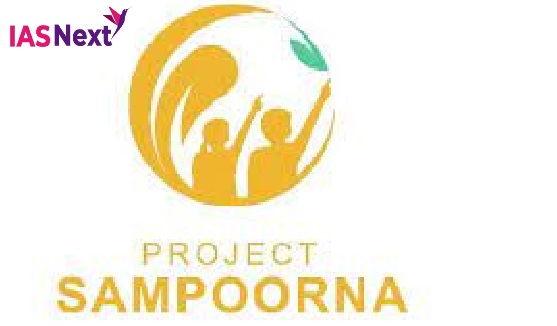CURRENT AFFAIRS
Get the most updated and recent current affair content on Padhaikaro.com
Project Sampoorna for Malnutrition
- IAS NEXT, Lucknow
- 11, Nov 2021

Reference News:
Project Sampoorna which was successfully implemented in Bongaigaon district of Assam is a model that can be easily implemented anywhere in reducing child malnutrition
- The project has resulted in the reduction of malnutrition in children using near zero economic investment.
Vicious Cycle of Malnutrition
- Malnourished child growing into an unhealthy adolescent, and then further into an anaemic pregnant young woman giving birth to an asphyxiated low birth weight baby.
- This baby then facing possible developmental delays, only to grow into a malnourished child; and this child who struggles further for nutrition.
- In order to break out of this vicious cycle, the low-hanging fruit had to be targeted — children’s nutrition.
About Project Sampoorna
- Bongaigaon district in Assam has a total of 2,416 malnourished children; 246 cases of Severe Acute Malnutrition (SAM) and 2,170 instances of Moderate Acute Malnutrition (MAM).
- Based on the success of the community-based COVID-19 management model (Project Mili Juli), Project Sampoorna was launched targeting the mothers of SAM/MAM children, the tagline being ‘Empowered Mothers, Healthy Children’.
- The mother of a healthy child of the same Anganwadi Centre (AWC) was identified and paired her with the target mother; they would be ‘Buddy Mothers’ (2,416 pairs).
- They were usually neighbours and shared similar socio-economic backgrounds. The pairs were given diet charts to indicate the daily food intake of their children;
- Buddy mothers would have discussions about this on all Tuesdays at the AWC. Local practices related to nutrition would also be discussed.
- 100 millilitres of milk and an egg on alternate days was arranged for all 2,416 children for the first three months, giving time for their mothers to stabilise themselves in the newly found jobs.
- The project has yielded encouraging results; maternal deaths for six months have fallen from 16 to three and infant deaths from 130 to 63.
- By March 2021, 84.96% of SAM children and 97.3% MAM children were normal.
- Children who had not improved were checked and treated by doctors under the Rashtriya Bal Swasthya Karyakram (RBSK).
What were the hurdles for the project?
- The major hindrance to the project was patriarchy. Mothers had to be empowered financially for sustained results.
- Therefore, they were enrolled in Self Help Groups (SHGs) under the National Rural Livelihoods Mission (NRLM). By the end of three months, 74.3% of mothers were enrolled in SHGs and by the end of a year, it was 90%.
Conclusion
- Project Sampoorna had prevented at least 1,200 children from becoming malnourished over the last year.
- The National Nutrition Mission and the State government recognised our project in the ‘Innovation Category’.
- The model can easily be implemented anywhere in the world.